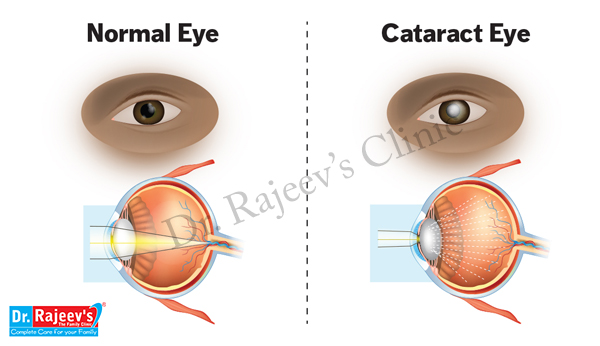

A cataract is a clouding of the lens, which lies behind the iris and the pupil. The lens works like a camera by focusing the incoming light onto the retina and it also adjusts the eyes focus, letting us see things clearly both up close and far away. The protein in a lens is arranged in a precise way that keeps the lens clear and let light pass through it. In case of a cataract some of the protein has clumped together and has formed a cloud in a small area of the lens.
Over time, it may grow larger and cloud more of the lens, making it harder to see. It is said that the cause of this cataract is due to changes in the protein structure as we age.
A cortical cataract starts of on the outside of the lens and slowly extends to the center. This cataract is common for people with diabetics.

A sub capsular cataract begins at the back of the lens. People who have a higher risk of developing this form of cataract are:
The term "age-related" is a little misleading because people can have an age-related cataract in their 40s and 50s. But during middle age, most cataracts are small and do not affect vision. It is after age 60 that most cataracts have a serious impact on ones vision
Each type of cataract has its own symptoms. With a nuclear cataract one may notice an improvement in their near vision. This is called 'second sight'. However when the cataract gets worse this will disappear.
A sub capsular cataract may not give any symptoms in the beginning, but only in a later stage when it is more developed.
The most common symptoms of a cataract are
These symptoms also can be a sign of other eye problems. If one have any of these symptoms,they must have to go for checkup.
When a cataract is small one will not notice it much.One may find that their vision is a little blurry, like looking through a cloudy piece of glass. Cataracts tend to "grow" slowly, so vision gets worse gradually. Over time, the cloudy area in the lens may get larger, and the cataract may increase in size. Seeing may become more difficult
Another way that cataracts can affect our vision is that the clear lens slowly changes to a yellowish/brownish color, adding a brownish tint to vision
At first, the amount of tinting may be small and may not cause a vision problem. Over time, increased tinting may make it more difficult to read and perform other routine activities. This gradual change in the amount of tinting does however not affect the sharpness of the image transmitted to the retina
If one have advanced lens discoloration,they may not be able to identify blues and purples.One may be seeing black instead of purple or blue
It is unclear that what is the exact cause of catarract .
Some of the causeative factors are
Homeopathy treats the person as a whole. It means that homeopathic treatment focuses on the patient as a person, as well as his pathological condition. The homeopathic medicines are selected after a full individualizing examination and symptoms totallity, which includes the medical history of the patient, physical and mental constitution etc.
CALCAREA CARB : Very useful medicine for cataract when a person has the feeling of looking through a mist.Given when person feel chilliness,having swollen glands, weight problems and get easy tired from exertion
CALCAREA FLOUR : Well indicated medicine for cataract when tissues harden or thicken abnormally.There is tendency toward hard swollen lymph nodes, joint pains, fibrous growths, or bone-spurs.Given when person generally feels worse during weather changes and improved by warmth.
CAUSTICUM : Helpful in developing cataracts when person had problems moving the eyes, as if the muscles around the eyeballs were stiff or weak.Given when symptoms get worse especially after getting cold in the wind or open air. There is feeling of sand in the eyes.Given to those persons who may tend to have muscular stiffness in many body areas.Recommended when sympoms get generally worse from cold and improved by warmth, and often feel best in damp or rainy weather.
SILICEA : Helpful for cataract on those who developed cataracts after extended periods of eyestrain, or after perspiration of the feet had been suppressed.There is tendency toward chill (although they often sweat at night) and often have low resistance to infection. Especially suited to those person who has fine hair, weak nails, easy tired, and swollen lymph nodes.
NATRUM MUR : Mostly indicated when cataracts begin to develop.Given when muscles around the eyes can feel bruised and weak, especially when the person looks down. There is feeling of gauze across the eyes, and parts of the field of vision may be hard to focus on. There is craving of salt.Patient feels worse from being in the sun, and has deep emotions yet appears to be reserved.
PHOSPHORUS : Useful for cataract with feeling that dust or mist in the eyes is obscuring vision.There is soreness that feels like eyestrain after very little use.Given when there is appearance of little bright dots of colored light when the eyes are closed. Suited to those people who are sympathetic and fond of company, but can tire easily. There is an active imagination (including many fears) and a strong desire for cold drinks and refreshing things
RL-46 : Cataract Glaucoma & Eye Vision Drop
Or AS DIRECTED BY PHYSICIAN